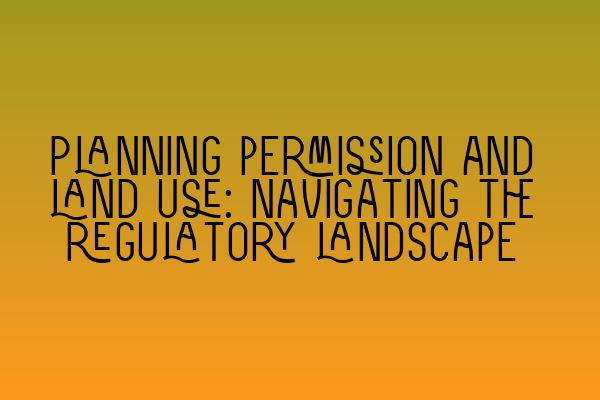Planning Permission and Land Use: Navigating the Regulatory Landscape
When it comes to property development, one of the most important aspects to consider is planning permission. Obtaining the necessary approvals from the local authorities can be a complex and time-consuming process. Understanding the regulatory landscape surrounding planning permission and land use is crucial for anyone involved in property transactions or development projects.
What is Planning Permission?
Planning permission is the official consent required from the relevant local planning authority to carry out certain types of development on a property or a piece of land. It ensures that the proposed development aligns with the local development plan and is in line with local planning policies. Without planning permission, any development may be considered illegal, and the local authority can take enforcement action, resulting in penalties or even demolition.
Obtaining planning permission is not only necessary for new builds but also for changes of use, extensions, conversions, and certain alterations to existing buildings. It ensures that development is carried out in a controlled and sustainable manner, taking into account factors such as transportation, environmental impact, and the surrounding community’s needs.
The Planning Permission Process
The planning permission process can be divided into several stages:
- Initial Research: Before embarking on any development project, it’s essential to conduct thorough research to understand the local planning policies and guidelines. This research will help determine the probability of obtaining planning permission for the proposed development.
- Pre-application Consultation: Engaging in pre-application consultations with the local planning authority can provide valuable insights and guidance regarding the proposed development. This step allows for early feedback and can help in identifying any potential issues or concerns.
- Preparing and Submitting the Application: Once all the necessary information and supporting documents are gathered, the planning permission application needs to be prepared and submitted to the local planning authority. The application should include detailed plans, designs, surveys, and other relevant information specified by the authority.
- Public Consultation: In certain cases, the local planning authority may require public consultation, especially for significant developments that may impact the local community. This stage involves gathering feedback from local residents, businesses, and other stakeholders to assess the community’s views on the proposed development.
- Assessment and Decision-Making: The local planning authority reviews the application, considering factors such as impact on the environment, traffic, infrastructure, and compliance with local planning policies. The authority may request additional information or consult with other relevant parties before making a decision.
- Decision and Appeal: Once the assessment is complete, the local planning authority issues a decision notice. If planning permission is granted, the applicant can proceed with the development. However, if the application is refused, there is the option to appeal the decision to a planning inspectorate or through the courts, depending on the jurisdiction.
Challenges and Considerations
Obtaining planning permission can be a challenging and time-consuming process. It requires careful consideration of various factors, including:
- Local Planning Policies: Understanding the local planning policies and guidelines is crucial for ensuring a smooth planning permission process. These policies outline the preferred land use in different areas, guiding the type of development that is acceptable.
- Environmental Impact: Developers must consider the environmental impact of their proposed development. This includes factors such as energy efficiency, sustainability, and the preservation of natural habitats and wildlife.
- Community Engagement: In some cases, developers may face opposition from local residents or community groups. Adequate community engagement and addressing concerns can help in gaining support for the proposed development.
- Legal Considerations: There may be legal challenges or disputes related to planning permission. It’s crucial to seek legal advice to ensure compliance with all relevant laws and regulations.
For a comprehensive guide on legal challenges in property transactions, click here.
Land Use and Future Implications
Land use planning plays a crucial role in shaping the future of our communities. It ensures that development is carried out in a sustainable and harmonious manner, considering factors such as housing needs, infrastructure requirements, and environmental impact. By obtaining planning permission, developers contribute to the overall growth and development of the area within the legal and regulatory framework.
To avoid common pitfalls in property law questions, check out our guide here.
Studying land law is essential for anyone involved in property transactions. To ace your exam preparation, make sure to read our comprehensive guide on land law revision tips: click here.
When considering property transactions involving mortgages, it’s important to understand the essential considerations related to land law. For more information, read our article here.
Conclusion
Navigating the regulatory landscape surrounding planning permission and land use can be a complex process. Understanding the requirements, engaging with the local planning authority, and addressing any concerns or objections is crucial for obtaining the necessary approvals. With proper research, preparation, and expert guidance, developers can successfully navigate the planning permission process and contribute to the sustainable and responsible development of our communities.
For more information on how land law balances development and sustainability, visit our article here.
